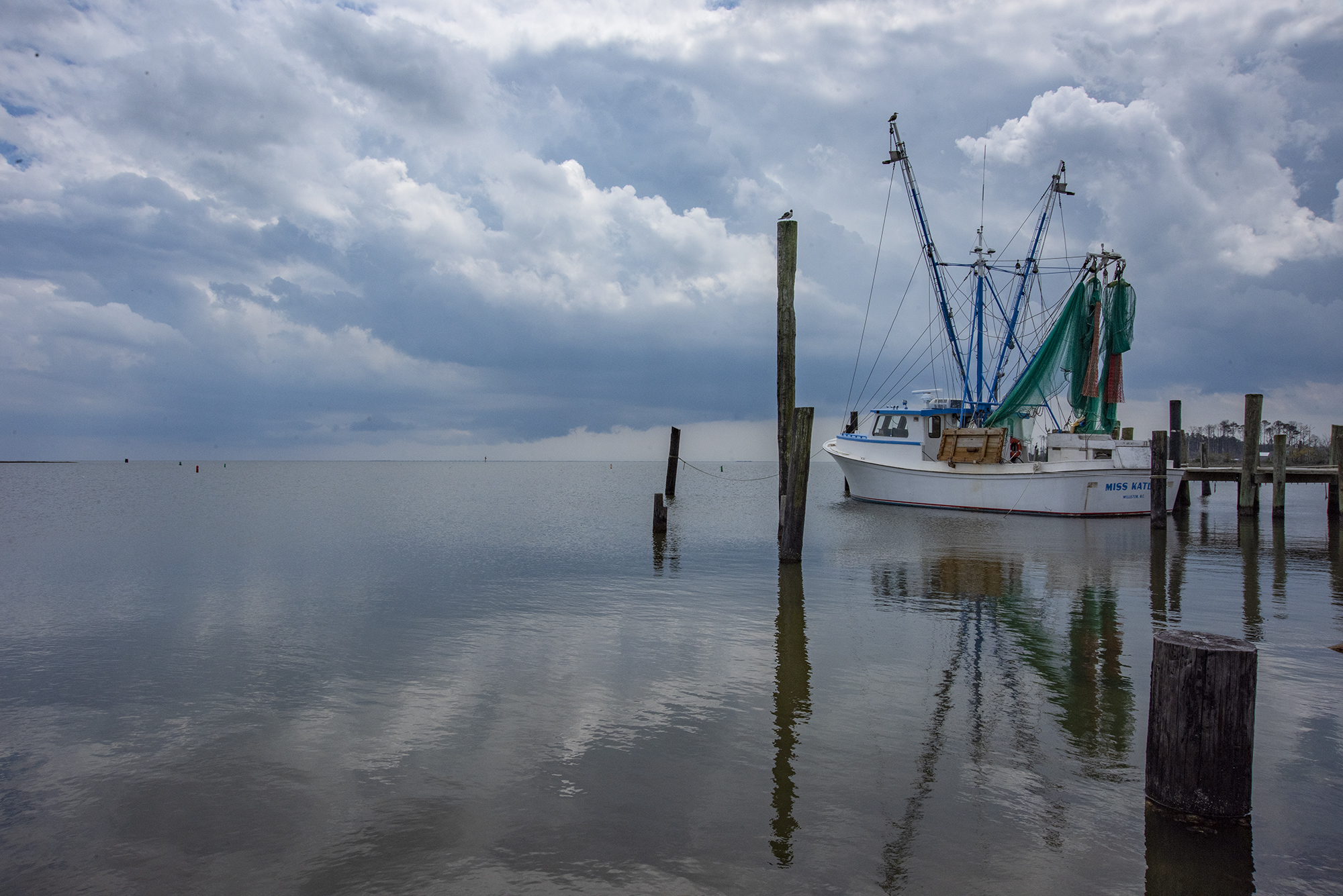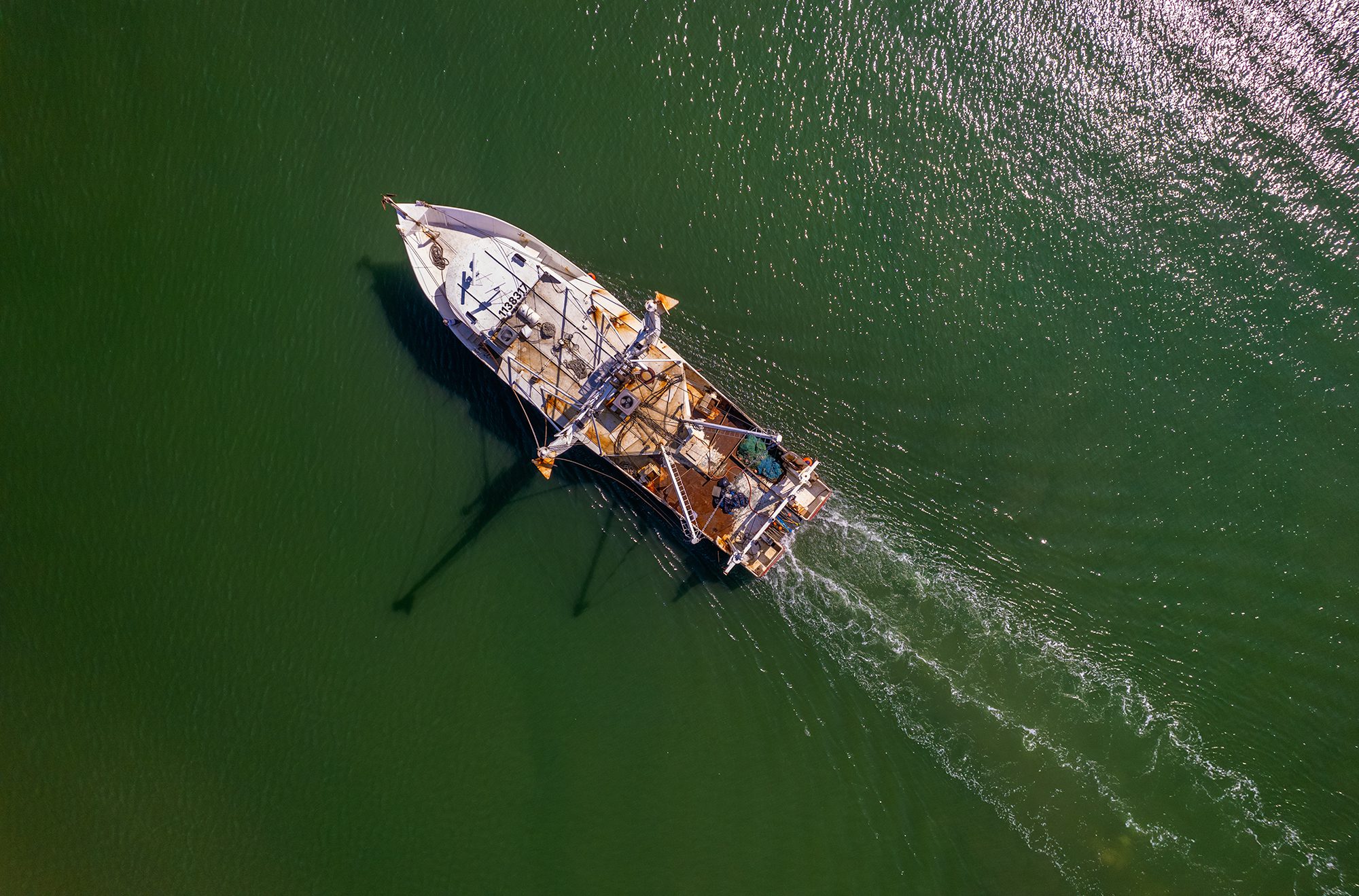Last of two parts
Living shorelines offer many benefits over the wooden and rock walls that are customarily used to control erosion along estuarine shores. But researchers say they have to be carefully planned and sited to make sure that “living shoreline” projects aren’t little more a bunch of rocks with a little grass thrown in.
Rachel Gittman knows that fish like a good living shoreline project. A graduate student at the University of North Carolina’s Institute of Marine Sciences in Morehead City, Gittman has been studying living shorelines and her research indicates that they are “fish-friendly.”
Supporter Spotlight
From June to October 2010, Gittman surveyed 25 salt marshes from Nags Head in the north to Cape Fear in the south, to see if fish could get behind the constructed sills and into the marsh.
What she found was that fish, mostly small, were able to get into the grassy areas of the marsh. There were even some larger predator fish, which came in to feed. And research after Hurricane Irene did nothing to dispel her initial assessments from two years ago, she said recently.
Carolyn Currin is a marine scientist with the Center for Coastal Habitats and Fisheries Research, a NOAA facility on Pivers Island in Beaufort. She has also been researching living shorelines for years, focusing on the structure and function of estuarine intertidal habitats, the marine food chain, fish production and restoration of salt marsh habitats.
Like Gittman, she has assessed how natural shorelines fared during Irene, and was impressed. In some cases, she said, the storm resulted in a net increase in sediments behind the sills.
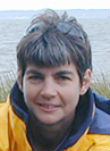 Carolyn Currin |
Currin understands that some developments, such as marinas, will always find bulkheads necessary and she knows that it’s hard to combat the views of many who like the aesthetics of bulkheads, with their straight lines and neat, trimmed grass right up to the wall. But her work has convinced her that living shorelines maintain ecosystems, fish habitat and the nutrient cycle, all while offering significant and cost effective erosion control.
Supporter Spotlight
Living Shoreline Problems
But living shorelines are not a panacea; there are still problems, major ones in the opinion of some.
Rob Young, head of the Program for the Study of Developed Shorelines at Western Carolina University; Orrin Pilkey, the famed geologist from Duke University; and other collaborators surveyed living shoreline projects along the Gulf and East coasts. A growing number, they concluded in the resulting report, Rethinking Living Shorelines, “are relying more on massive hard stabilization with less emphasis on natural stabilization or the development of a significant habitat component, as was the original intent of early ‘living shoreline’ projects.”
The ‘living shoreline’ projects in the report vary widely in design, the degree of stabilization, the amount of habitat creation and how well they’re monitored. Some projects are used to protect private property, and some are designed to reduce the erosion on the margins of existing wetlands, it notes.
“In short, the term living shoreline is being used to describe everything from well-constructed, vegetative stabilization projects to massive rock revetments where a small planting of marsh grasses seems to be an afterthought,” the authors add.
The researchers worry that the massive rock structures used in some of these ‘living shoreline’ projects will cause long-term environmental degradation, provide a false sense of accomplishment and shift the focus away from trying to maintain the most natural estuarine shoreline feasible.
 Rob Young |
“There is a need for advocates of ‘living shorelines’ to more precisely define and regulate this term so it is not misused simply to allow more unnecessary and damaging hard stabilization of estuarine shorelines,” the paper concluded. “We urge broad reconsideration of the use of large-scale hard stabilization for ‘living shorelines’ and a renewed scientific effort to evaluate the cumulative impacts of all existing structures (bulkheads and living shorelines) on natural and physical processes and ecosystems.”
Gittman and Currin said one source of the problems cited by Young is that many contractors simply don’t know much about living shorelines. They’re more accustomed to building bulkheads or other types of hard structures to control erosion, they said.
“I agree with him (Dr. Young),” Gittman said. “I’ve seen some good ones and plenty of bad ones. It’s about 50-50. There are definitely some challenges in terms of education. They’re (contractors) used to building walls, so that’s often what they will suggest. Some will say that sills are not tall enough. But many times all you need to do is have a sill that’s tall enough to baffle the waves a bit” so the marsh grass behind it can survive.
Braxton Davis, the director of the N.C. Division of Coastal Management, agreed that increased educational efforts are needed in order for natural shorelines to play a larger role in shoreline stabilization in North Carolina.
“Permitting isn’t the only factor, and permitting also isn’t the only factor driving costs,” he said. “We need to figure out ways to help people address the costs. Although living shorelines are perceived as expensive compared to bulkheads, that doesn’t always have to be the case. It depends on the project design.”
Cost On Par with Bulkheads
Currin insisted that living shorelines are not prohibitively expensive compared to bulkheads, and she and Davis both pointed to Weighing Your Options, a 50-page booklet put together for NOAA and the division. It shows how to build living shorelines, generally; gives cost estimates for bulkheads and a variety of living shorelines, including breakwaters, riprap revetments, vegetation alone, marsh sills and oyster reefs; and explores the benefits and drawbacks of all of them.
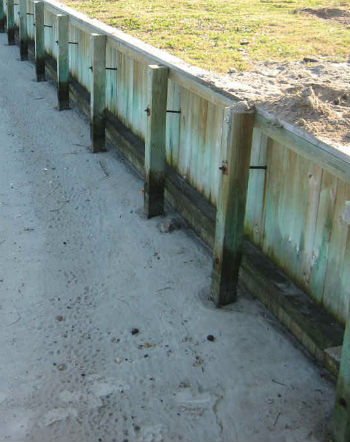 Wooden bulkheads are expensive to build and maintain. |
Bulkheads, the booklet says, cost an average of $135 a foot and require a lot of maintenance – backfill and repair of cracks and holes – with an average lifespan of 30 years. By contrast, it estimates that a marsh sill uses, averages about $130 a foot for stone work and site work. Planting, including labor and the plants, averages about $22 a foot. Again, maintenance is required.
A key, Currin said, is working with someone who has expertise, both in picking the right system for a landowner’s particular piece of shoreline – location and the energy of the waves and wakes, as well as tidal fluctuations, are key factors – and in actual construction. But some of the labor – as evidenced by thousands of volunteers who work on projects around the nation – does not need to be turned over to a contractor.
She and other advocates of living shorelines point out, too, that a natural system has an overriding public benefit: preservation of salt marshes, which are among the most productive habitats in the world.
In nature, marshes retreat landward as they are buffeted by tides, waves, wakes and rising sea levels. But a bulkhead prevents that retreat, and a marsh so blocked will eventually disappear.
Currin agreed there are problems with some projects, but said that given the potential for living shorelines to positively impact both water quality – filtering pollutants – and marine habitat, as well as shoreline erosion, the state needs to continue to try to make it easier to build living shorelines and harder to build bulkheads.
“It’s going to take time, because it’s a different philosophy than most people have had in the past,” she said. “But I think they (the state officials) are moving in the right direction.”
More Training Needed
Davis said the state can also help simply by encouraging property owners to explore the alternatives to bulkheads and said his office is doing that much more often than in the past.
“We’ve done training for our staff, and we’re developing training courses (for contractors and others),” he said. “Our field staff is encouraged to ask people who want to stabilize the shore, ‘Have you explored this.’ Sometimes, though, that happens too late in the process.”
The state, he said, is continuing to learn more about shorelines stabilization and about exactly what techniques are used and how those techniques fare in storms.
“We’re looking at that, and we also just finished our first digital map of the entire North Carolina shoreline,” he said. “For the first time, we have good clear images of all of the types of structures. This will allow us to evaluate better the extent and the effectiveness of those structures.”
But Young said he doesn’t favor the “general” permit approach for living shorelines, because it shouldn’t be too easy to do anything that alters the natural shoreline. He’s not, he said, ever going to say he wants to see “rocks put in the water.”
But he doesn’t want anyone to get the opinion, from his paper, that he thinks living shorelines are worse than bulkheads.
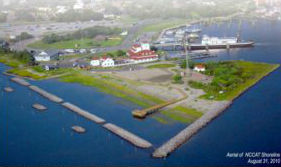 The NCCAT project in Ocracoke was “over-built” to meet some unusual circumstances. |
“The real problem is the rate at which we are armoring our estuarine shoreline, locking it off, causing incredible damage, particularly if sea level continues to rise,” he said. “What we were saying is that we saw many ‘living shoreline’ projects that were mostly engineered structures with a little bit of marsh grass, lipstick on a pig.
“The Coastal Federation, I would say, does a good job with their projects, certainly a better job than most. Their projects generally have a large degree of ‘natural’ material,” Young said. “But if you look at the project that’s on the cover of our paper – at the North Carolina Center for the Advancement of Teaching on Ocracoke – well, let’s just say that I’d rather not see them involved in any more projects like that one in the future. That shouldn’t be the model.”
Some special circumstances drove the design of that project, noted Erin Fleckenstein, a federation coastal scientist. A few bags of oyster shells and some marsh grass seedlings wouldn’t have worked there, she said, because of the battering the site takes. Large waves – for Pamlico Sound — generated over a long stretch of open water are routine, Fleckenstein explained. So are large wakes kicked up by state ferries and other large vessels entering the adjacent entrance to Ocracoke’s harbor.
The center is in a remodeled former Coast Guard station. The state wanted a finished product that would protect its $5 million investment, Fleckenstein said.
“It’s over-built by Coastal Federation standards,” she said. “But given those other parameters, it’s totally appropriate.”
Other states, including Mississippi, are moving toward making it too easy, Young said, to permit living shoreline projects “before we have really agreed on what a ‘living shoreline’ is. If we’re going to go in that direction, than we had better have a damn good idea of what is really a ‘living shoreline’ and what is really an engineered shoreline stabilization project with a little bit of a natural component,” he said.
“I don’t think NOAA has drawn that line yet, and I don’t think the Coastal Federation has, either. We need to have that conversation, and I think any organization that is trying to ‘sell’ living shorelines should be happy to have that conversation.”
Young also said he realizes it’s impractical to insist that shoreline stabilization never take place, because there are some developments along high-energy shorelines that are going to be protected, whether anyone likes it or not. The goal should be to strictly limit those and to use real natural shoreline projects – as “gentle an approach as possible,” Young said – whenever something must be done and natural shorelines will work. And, of course, to encourage letting nature have its way – shoreline retreat – as much as possible.
The problem “in a nutshell,” Young concluded, is that it’s easy to quantify, in dollars the enormous losses when erosion destroys developed shorelines. There’s tremendous pressure not to let that happen.
It’s not so easy to quantify the damage caused by the loss of estuaries due to shoreline projects that increase pollution and destroy of critical marsh habitat.





